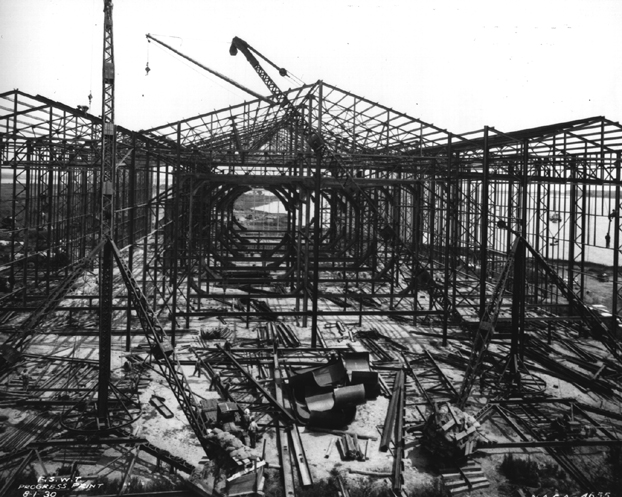Space History Photo: Construction of the 30 x 60 Foot Wind Tunnel at Langley

In this historical photo from the U.S. space agency, the 30 x 60 Foot Tunnel is under construction in August of 1930. Smith J. de France, a NACA engineer, was in charge of the design team for the new tunnel. Planning involved the construction of a 1/5 scale model of the tunnel.
In 1929, the NACA received congressional approval and two year appropriation of $900,000 for construction. The tunnel was built by the J.A. Jones Construction Company. The framework is solid steel.
Like many early wind tunnels, the 30 x 60 foot tunnel featured "inside-out" construction, with structural supports on the outside. The circular frames indicate where the two 35 foot propellers are located today.
Built to test full-scale models or actual aircraft, the 30 x 60 foot tunnel was an innovative concept in wind tunnel design. It proved especially valuable during World War II as a majority of the nation's bombers and fighters (as well as several foreign aircraft) were tested in this tunnel.
Since the 1970s, one of the unique test techniques used in the 30 x 60 was free flight of dynamically scaled models in the test section. This technique allowed researchers to measure and assess flight characteristics as well as control options. The 30 x 60 is an example of a major facility adapted to serve a multitude of uses that its designers did not initially visualize. The 30 x 60 remained as one of NASA's largest wind tunnels until its closing in September 1995. In 1985 the 30 x 60 foot wind tunnel was designated a National Historic Landmark.
The National Advisory Committee on Aeronautics (NACA) was a precursor to NASA. NACA was created by Congress in 1915.
Each weekday, SPACE.com looks back at the history of spaceflight through photos (archive).
Breaking space news, the latest updates on rocket launches, skywatching events and more!

The National Aeronautics and Space Administration (NASA) is the U.S. government agency in charge of the civilian space program as well as aeronautics and aerospace research. Founded in 1958, NASA is a civilian space agency aimed at exploring the universe with space telescopes, satellites, robotic spacecraft, astronauts and more. The space agency has 10 major centers based across the U.S. and launches robotic and crewed missions from the Kennedy Space Center in Cape Canaveral Florida. Its astronaut corps is based at the Johnson Space Center in Houston. To follow NASA's latest mission, follow the space agency on Twitter or any other social channel, visit: nasa.gov.
